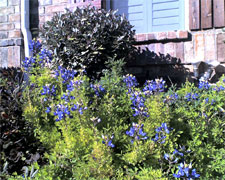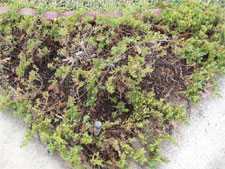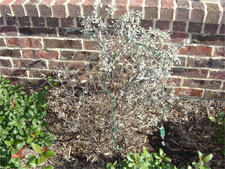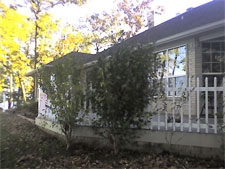Question and Answer – February 2009
We would love to have your questions. Neil answers 5-10 of the questions that will be of greatest general reader interest and usefulness, but priority is always given to those that are accompanied by a photo. Also, gardening is very site-specific due to climate and soils. Be sure you tell us the city in which you live.

Question: The attached picture shows some of my bluebonnets several weeks ago. Since then, they have wilted slightly from frost. Isn’t it unusual for bluebonnets to thrive year-round? Do you know more about this perennial variety of bluebonnets? J.F., no city given.
Answer: Bluebonnets are in the big plant genus of lupines (Lupinus). Most of the members of the genus actually are perennials, but most of them can’t handle Texas’ summer heat. They also don’t look much like our state wildflower bluebonnets. However, your plants obviously do look like the wildflower type. Granted, it’s an annual flower that germinates in the fall, grows roots through the winter, then blooms the following spring before going to seed and starting the process over again. My guess would be that you have the annual. See how it survives the balance of the winter. It would have helped to have known where you and the plants are.

Question: Attached are pictures of my sickly juniper and another that’s 2-1/2 feet away and healthy. The sickly juniper began to decline in late spring of 2008. I thought the problem might be spider mites, so I treated it with pyrethrin for at least three months without significant change. There were some signs of growth during the summer, but those fresh green sprouts eventually turned brown as well. I have treated it with a fungicide and have fertilized it, but it has continued to decline. Both plants are about 10 years old and get water as part of the sprinkler system. I hoped that whatever was creating the damage would stop during the cold weather, and that I’d see the juniper begin to regain its fullness, but so far it looks like it’s still in decline. I’m at the end of what I know to do. B., Garland
Answer: Your first instinct was probably right. This looks exactly like spider mite damage. Thump some of the twigs with yellowing needles over a sheet of white paper. You should be able to see the nearly microscopic mites on the paper. Use a general-purpose insecticide such as malathion to stop them. Pyrethrins are not as effective. For the record, the mite species that attacks trailing junipers and other conifers is active during the winter. Almost all other mites aren’t active at all until the summer’s hot weather.

Question: I am having trouble with a compact sage bush in front of my house, which faces west. About a month ago the leaves started turning black in one area. After Internet research, I concluded it might be a mildew problem, so I sprayed with the same substance I use on the crape myrtles. The problem has not gotten better and seems to be spreading. My soil is black gumbo, but we enriched the beds with some good soil before planting. (The bush was planted in the fall one year ago.) We fertilized a few times during the growing season with a popular product, and I am sure that no weed killers have gotten into this bed. T.W., Princeton
Answer: Your information is perfect. I wish that my answer could be half as good. Unfortunately, I can’t tell whether this might be due to soil that stayed too wet for too long for a ceniza plant, or whether there might have been some lace bug damage late in the growing season. They are the only insect or disease I’ve ever seen on Texas sage, and they cause the leaves to turn a light tan color before they drop. In those rare years when they show up on cenizas, a systemic insecticide such as acephate (Orthene) works well. Spring will give you a better idea of whether your plant will make it, but it doesn’t look good from the photo.

Question: I took this photo a few weeks ago before these altheas lost their leaves. Our house is southeast of Dallas, on the south side of Richland Chambers Lake in Freestone County. The plants partially block our view of the lake. I would like to keep them, but reduce the size. Is it OK to prune the height and width overall like a holly, or should I remove stems (as if pruning nandina) without shortening any branches? Thanks. K.C., Freestone County.
Answer: You could do either, but neither will be completely satisfactory. The reason we cut nandina stems back to the ground is to encourage them to send up many new shoots to take their places. Althaeas don’t operate that way, so about all you can do is thin out the canopies to allow you to see through them. That will be incredibly temporary, however. New growth will quickly fill in, so it will probably never be a long-term solution. And, if you whack them back below the height of your railing, you’ll ruin their shapes. If they were mine, I’d transplant them to other places where they can grow to their full mature size and form. Make the moves now, while the plants are completely dormant. Hold the soil around their root systems intact as you move them.

